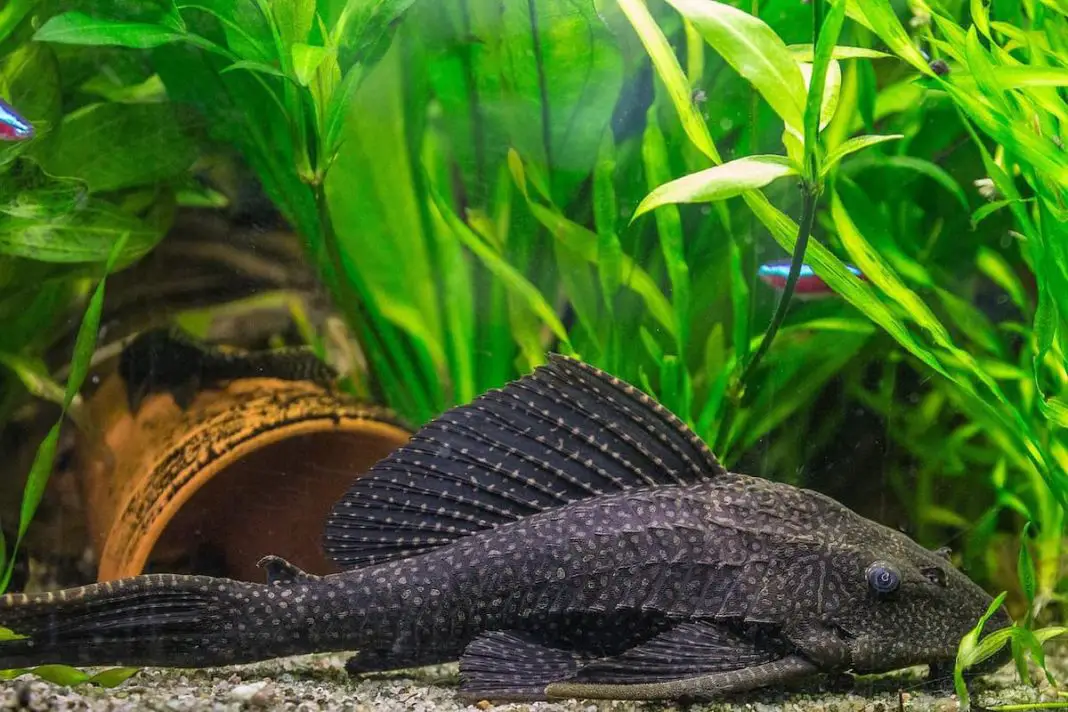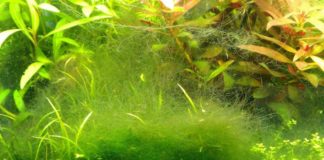Quicklinks
- How To Feed A Pleco Cucumber?
- Do Plecos Need Vegetables?
- What Vegetables Can Plecos Eat?
- Why You Should Use Organic Vegetables
- Having Problems Sinking Vegetables?
- What To Do If The Pleco Won’t Eat Vegetables
Cucumbers are a popular vegetable to feed pleco catfish. Not only is it relatively cheap, it’s also very easy to find, which makes it a good choice. On top of that, plecos love it!
Cucumber can be made to sink using a fork or spoon and it should be eaten by most plecos. It’s best to feed cucumber raw, in order to keep it firm. You should remove the seeds, to prevent the half-eaten cucumber from making a big mess in the tank.
Even though it’s a popular vegetable to feed a pleco, there’re many other alternatives that can be used.
How To Feed A Pleco Cucumber?
Most plecos love cucumbers and it provides variety in their diet. Another benefit is that some fish in a tank will also enjoy eating it, especially if there’re clown loaches or cichlids in the tank. A common problem when feeding cucumbers to a pleco is that the cucumber floats in water and, of course, the cucumber is intended for the tank’s bottom feeders. Therefore, you need to devise a way to sink the cucumber to the bottom of the tank, making it easy for the plecos and bottom feeder to get at.
Preparing Cucumber For Plecos
Before feeding, wash the cucumber well in clean water, and dry using paper towels. It’s important to remove anything on the surface of the cucumber, such as wax, that can adversely affect an aquarium.
Slice a piece of the cucumber about ½ inch thick.
In order to get the slice of cucumber to fall to the bottom, stick a cucumber slice on the end of a stainless-steel fork. Only use a steel fork, as a fork that’s made of any other material, could release harmful substances into the tank’s water. The fork is used to provide the weight for sinking the cucumber slice. If you’re struggling with getting your cucumber to sink, there are commercial sinking implements that you can use to impale and weight the cucumber.
Observe your pleco as they enjoy their slice of cucumber. Remember to remove and sinking elements and if they don’t finish the slice of cucumber and lose interest, remove uneaten portions of cucumber immediately so that it does not contaminate the tank.
Do Plecos Need Vegetables?
In the wild, plecos will feed on a variety of different foods. Most pleco species are omnivores, and eat whatever is available, algae, snails, shrimps, or plant material.
That means that in order for plecos to be healthy, a varied diet should be fed. Many kinds of fresh vegetables contain useful fibers and vitamins that are beneficial for plecos. This nutrition helps to benefit the digestive system of your pleco.
Even if you feed a wide variety of commercial pellets, it’s still recommended to occasionally feed them some vegetables.
What Vegetables Can Plecos Eat?
There are many other options to feed your pleco. In fact, most vegetables that are suitable for humans can also be given to a pleco. Of course, not all vegetables have the same benefits. This list consists of some of the most popular vegetables that are fed to plecos.
Keep in mind that your pleco probably has its own personal preference. Some may prefer certain vegetables over others, which is normal.
Broccoli
Broccoli seems to be a vegetable that almost all plecos enjoy. The common pleco especially seems to love eating at the florets of this vegetable.
Keep in mind that broccoli can create quite a mess in the tank. As the plecos grasp on the florets, it can cause pieces of the broccoli flying through the tank.
Brussel sprouts
Although brussel sprouts can be given to plecos, in order to get brussel sprouts to sink, boiling them is needed. After being boiled for a few minutes, brussel sprouts should sink to the bottom of the tank. It’s not recommended to cut the Brussel sprouts into pieces, there’s a chance that the sprouts will fall apart and create a mess.
If you’re boiling the brussel sprouts, make sure to let the brussel sprouts cool down after boiling as they get really hot, which can be dangerous for a pleco.
Zucchini
Zucchini is a great alternative to cucumbers. Its similar form not only makes it easy to feed, it’s also more nutritional than cucumber.
Sweet Potato
Sweet potatoes are another great vegetable for wood-eating pleco species as they contain a lot of fibers. The peel of the potato should be removed before feeding.
A big advantage of feeding a pleco sweet potato is that it can be left in the tank for up to two days, without falling apart.
Pumpkin
Pumpkin is a vegetable that has a lot of success with plecos. Before feeding pieces of pumpkin, it’s recommended to remove the peel of the pieces of pumpkin.
Lettuce
Romain or loose-leaf green lettuce is a popular vegetable fed to plecos. It can be fed raw and weighed down. Iceberg or any other colored variety isn’t the better variety of lettuce to feed plecos, as they’re low in nutritional value as well as possibly containing harmful chemicals.
Keep in mind that lettuce can come apart in the tank quickly. This could cause the tank to become messy, and you may need to pick out any uneaten lettuce.
Why You Should Use Organic Vegetables
Even though organic vegetables aren’t necessarily more nutritional, you can be sure that there’re no pesticides or other harmful chemicals have been used.
When feeding plecos, it’s important to give the vegetables a quick clean, so that no pesticides or other harmful chemicals won’t harm anything in the tank.
Having Problems Sinking Vegetables?
If you’re having problems sinking vegetables, you can get a pleco feeder. This device was specifically created for feeding vegetables to plecos. It’s a long stainless-steel tool that allows you to secure the pieces. This is a great option for anyone looking for an easy way to feed vegetables.
Although commercial pleco feeders are useful, they can be quite expensive. So, if you’re looking for a cheaper option, read on.
A Cheaper Option To Pleco Feeders
One of the best and cheapest ways to secure vegetables to the bottom of a tank is by using specialized clips. These clips can be attached to the tank’s glass by using either a suction cup.
What To Do If The Pleco Won’t Eat Vegetables
Although many plecos enjoy eating vegetables, there are some plecos that won’t touch any vegetables. A common cause for this is that the pleco doesn’t recognize the vegetable as a food source. Another reason could be due to the pleco being a meat-eating species, so naturally won’t eat vegetables.
Some people recommend infusing pieces of vegetables with garlic scent to attract plecos. You can do this by crushing a garlic clove and adding it to the water while boiling/blanching the vegetable. The vegetable will suck up the scent of garlic, which should attract the pleco.
It can sometimes be tricky to get the pleco to realize that the vegetable is a source of food. Once the pleco has started eating vegetables, it will soon recognize it as a food source, and the garlic will no longer be needed.
Conclusion
Vegetables can be a great addition to most pleco species’ needs. As most plecos are omnivores, they should enjoy eating the vegetables you give them. These plecos include the bristlenose, clown, and common pleco. Some plecos, like the zebra pleco, are mostly carnivorous and won’t benefit from eating vegetables.
Although it can be a challenge to get vegetables to sink, using forks/spoons or specialized tools like the pleco feeder or a veggie clip will help.
If your pleco doesn’t seem to eat any pieces of vegetables you give them, it’s likely not realized that it’s a food source. Infusing the vegetable with some garlic should help the pleco figure out that it’s a food source.








